In June 2012 Rare Transit of Venus Took Oplace When Does It Ahppen Again
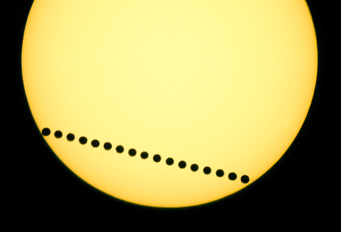
Fred Espenak combined 17 exposures taken at 20-infinitesimal intervals to create this sequence from the transit of Venus in June 2004.
Fred Espenak
Often we're told about a particular astronomical event — eclipses and planet line-ups, for example — that happen only rarely. But Venus crossing the face of the Sunday on June 5–6, 2012, takes "rare" to a new level. Don't miss adjacent week'southward chance to see this, considering you'll never have another gamble in your lifetime.
June's angelic spectacle, chosen a Transit of Venus, happens simply four times every 243 years. However, the spacing between each occurrence is very uneven: it's 121½ years, then 8 years, then 105½ years, then 8 years over again. The terminal transit of Venus occurred in June 2004 — and afterwards this June'due south event at that place won't exist another until December 2117.
Fortunately, unlike the narrow, fleeting path of visibility for a total solar eclipse, the upcoming transit of Venus volition final for nearly half dozen½ hours and tin can be seen from more than half of World's surface.
Where To Run into The Transit of Venus
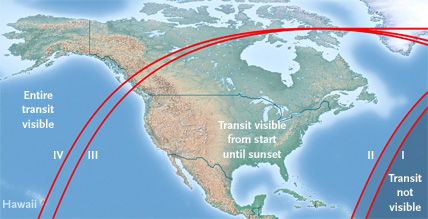
For virtually of North America, the transit of Venus will begin on the afternoon of June fifth and still be in progress at dusk. Those in western Pacific, eastern Asia, and eastern Australia encounter the whole show from beginning to cease on June 6th (local date). Click on the epitome for a larger, worldwide map.
Michael Zeiler / Eclipse-maps.com
As the map hither shows, North Americans are positioned to see at least a portion of information technology on the afternoon of June 5th. Unfortunately, virtually anybody in S America volition miss out. On the other side of the globe (click on the map), portions of the transit of Venus are observable at or subsequently sunrise on June 6th from Europe, northeast Africa, due west and due south-central Asia, and western Commonwealth of australia.
The best-positioned skygazers are those in east asia, eastern Australia, Alaska, New Zealand, and all of the Pacific from Hawaii westward. They have ringside seats for watching the entire transit, including the crucial events around both its start and finish.
Seen from anywhere on Globe, the transit starts inside a few minutes of 22:10 Universal Time (6:10 p.m. EDT) on June fifth and ends within a few minutes of four:45 UT June 6th. The two tables beneath offer local times for a sampling of cities positioned to see at to the lowest degree parts of the event.
| Transit of Venus Event Times — June 5, 2012 | ||||
| City | Ingress begins | Ingress complete | Deepest transit | Sun'south distance |
| Calgary | 4:05 pm | 4:23 pm | 7:26 pm | 19° |
| Chicago | 5:04 pm | 5:22 pm | 8:26 pm | 0° |
| Dallas | five:05 pm | v:23 pm | eight:26 pm | 0° |
| Denver | 4:05 pm | iv:23 pm | 7:26 pm | nine° |
| Halifax | seven:03 pm | vii:21 pm | — | — |
| Los Angeles | 3:06 pm | 3:24 pm | 6:26 pm | xviii° |
| Mexico City | 5:06 pm | five:24 pm | — | — |
| Miami | 6:05 pm | 6:22 pm | — | — |
| New York | 6:04 pm | half-dozen:21 pm | — | — |
| Québec | 6:04 pm | 6:21 pm | — | — |
| Seattle | three:06 pm | 3:24 pm | 6:26 pm | 23° |
| Transit of Venus Event Times — June 6, 2012 | ||||
| Urban center | Deepest transit | Sun'due south distance | Egress begins | Egress complete |
| Bangkok | 8:32 am | 36° | 11:32 am | 11:fifty am |
| Berlin | — | — | 6:37 am | six:55 am |
| Bombay | vii:03 am | xiii° | 10:05 am | x:23 am |
| Cairo | — | — | six:38 am | 6:56 am |
| London | — | — | five:37 am | 5:55 am |
| Moscow | 5:31 am | 4° | 8:37 am | eight:54 am |
| Rome | — | — | six:38 am | 6:56 am |
| Stockholm | three:30 am | 0° | half dozen:37 am | vi:54 am |
| Tehran | 6:02 am | two° | 9:07 am | 9:24 am |
Fred Espenak provides more extensive listings for cities in the United States, Canada, and elsewhere in the world. Y'all can also find precise times and circumstances for your exact location by clicking your position on the Transit of Venus map.
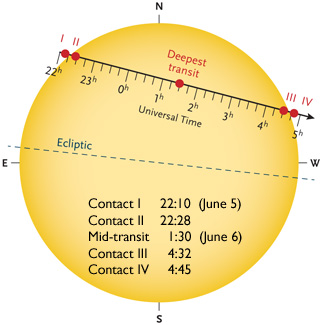
Venus will accept almost six hours 30 minutes to cross the northern side of the Dominicus. The line is plotted as seen from World's eye. Universal Times (as well geocentric) are given for the event'due south four contacts: I and II every bit Venus moves onto the Sun (called ingress), III and IV as information technology leaves (egress) and for Venus's deepest encroachment onto the solar deejay.
Southward&T: Leah Tiscione
Can You lot Meet The Transit of Venus Without A Telescope?
During its historic dash, Venus volition appear as a black silhouette 58 arcseconds wide, most 3% of the Lord's day'southward diameter. That's easily big plenty to be seen with any kind of optical assistance — and many observers should be able to glimpse the black dot with their eyes alone. Is your eyesight sharp plenty? Try this test, suggested past Baltimore observer Herman Heyn: Draw a black dot exactly 2 mm beyond on white paper. Put the paper in adept light and stand 23 feet, or 7 meters, away. Can you lot spot the dot?
Important: You'll demand to take careful precautions when attempting to view the transit. There are several good means to do this safely. Yous can view through special "eclipse shades" (non regular sunglasses) or a dark rectangular arc-welder's glass (#xiii or #fourteen). Or, you lot tin can set up your telescope or even tripod-mounted binoculars to project the Sun's image onto a white carte or other apartment surface. Solar filters are also fabricated to fit over the forepart of your telescope. Bank check out these safe-viewing options recommended past the editors of Sky & Telescope.
Transits And so and Now
The first known ascertainment of Venus crossing the Sunday was on December iv, 1639. A immature English astronomer named Jeremiah Horrocks had predicted the event after refining calculations by Johannes Kepler. "Horrocks completed his calculations in October 1639, barely a month before the transit," explains historian Eli Maor. "He hurriedly alerted a few friends, urging them to observe the rare event with utmost care. He knew that the transit would provide astronomers with an opportunity to mensurate Venus's apparent diameter, a job near incommunicable to achieve at any other fourth dimension due to the planet'south intense glare."
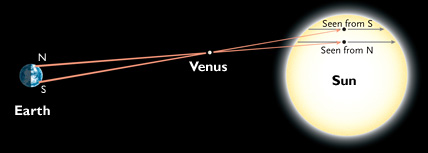
Your location north or due south on Earth slightly affects the apparent path you see Venus taking south or n across the Sun. In 1716, Edmond Halley realized that measurements of this offset, done past timing Venus's contacts with the Lord's day'southward edges, could be used to determine Venus's parallax as seen from Earth and hence the distance to both Venus and the Sunday. That in turn would give the correct scale of the entire solar system, which was poorly known at the time.
Sky & Telescope illustration
Yet Horrocks almost missed the take a chance to brand history — he spotted the planet'southward dark silhouette using a small refractor only a half hour before dusk! Learn how Maor carefully researched and retraced Horrocks'southward historic achievement.
Years later, Edmond Halley realized that careful timings of such transits, made from widely separated locations on Globe, could be used to determine the distance to Venus and thus, in turn, to the Dominicus and all the other known planets.
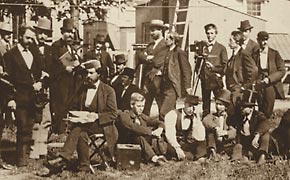
Observers and administrators gather at the U.Southward. Naval Observatory in Washington, D.C., in grooming for the American expeditions to time the 1874 transit of Venus.
Courtesy The states Naval Obs. Library
Halley's realization led to an all-out international blitz past astronomers to find the transits of 1761 and 1769. Notable among these was the unsuccessful quest by French observer Guillaume Le Gentil, who spent eleven years traveling but missed seeing either event. Finally returning to Paris, he found that he'd been alleged expressionless, his married woman had remarried, and his relatives had divvied up his manor. Captain James Cook had improve luck: on his first voyage, he observed the 1769 transit from Tahiti at a location nevertheless known every bit "Point Venus".
Many modern observers, both professional person and amateur, will again return to the Pacific to witness the upcoming transit. Some are heading to Tahiti to stand up where Cook and his crew had some 2½ centuries before; others are going to Hawaii, where the event concludes less than a half hr before sunset.
Weather Prospects
For those wishing to witness the entire spectacle, from ingress through egress, success will depend not simply on location (basically eastern asia and the western Pacific) but also on the weather.

Based on statistical averages of daytime clouds during June, the American Southwest, northern Australia, and the Middle East offer the all-time chances of articulate skies for the transit of Venus. Click here for a larger version.
Jay Anderson
"Within that zone," says meteorologist Jay Anderson, "i country stands out higher up all others for its articulate weather in early June: Australia." He notes that some climate stations in Queensland and the Northern Territory report having June days that are sunny, on average, at least 90% of the fourth dimension.
In the Usa, the best articulate-sky prospects are in the Southwest and along parts of the Pacific Declension. The odds get steadily worse eastward.
More Nigh the Transit
NASA's transit website (compiled by Espenak) provides a wide assortment of maps, tables, and technical details. So do the comprehensive transitofvenus.nl website, clustered by Steven van Roode and François Mignard; Chuck Bueter's transitofvenus.org, and Jay Pasachoff'due south transitofvenus.info.
There's no shortage of online resource to let you relive past events and to plan for the one in June. Here on SkyandTelescope.com, for example, yous can see how observers worldwide fared during the 2004 transit, which favored Europe, the Middle East, Africa, and most of Asia. Historian William Sheehan offers tales from the 18th and 19th centuries, and Anthony Misch describes how he and Sheehan created an animation of the 1882 transit using archived images. Sky & Telescope'south January 2012 outcome offers a detailed preview by Espenak and Anderson.
Here are more transit-related resources worth checking out:
• Lou Mayo of NASA'south Goddard Space Flying Eye (astronomer2go (AT) verizon.net) has established a Transit of Venus Working Grouping (TOVWG) to coordinate public-outreach efforts. He calculates that his efforts may achieve 50 million people past the time of the event.
• Larry Marschall's CLEA (Contemporary Laboratory Experiences in Astronomy) online/DVD pupil lab practice on the transit illustrates neatly how transit observations tin be used to measure the astronomical unit. The transmission with the do tells the history and method.
• Jean-Eudes Arlot of the Institut de Mecanique Celeste (IMCCE) at the Observatoire de Paris in France is analogous a public-outreach program that will apply pooled observations to re-measure the astronomical unit.
• Tying the event to the cutting edge of mod extrasolar-planet studies, a group of astronomers plans to report the light skimming through Venus's atmosphere during the transit — "firstly, to employ Venus as an instance of a transiting exoplanet. Astronomers volition employ the transit to test the techniques they have developed to analyse the composition, structure and dynamics of exoplanetary atmospheres. Secondly, they will be able to make simultaneous World- and infinite-based observations of Venus'due south atmosphere. These joint observations will give new insights into the complex center layer of Venus'due south atmosphere, a cardinal to understanding the climatology of our sister planet."
• Filmmaker Maarten Roos is making a documentary moving picture about transits of Venus.
• Jay Pasachoff (Williams Higher) has uploaded a 22-minute lecture about the transit of Venus, with historical discussions and contemporary science.
• The Canadian composer Victor Davies has written an opera, Transit of Venus, based on the play of that title by the Canadian playwright Maureen Hunter. It's about the expedition of Le Gentil (here's a plot summary). Information technology was performed past the Manitoba Opera in 2007 and is available for farther performances.
More South&T coverage of the transit of Venus:
See This Week's SkyWeek Video
Your Viewing Guide to the Transit of Venus
Volition You Run across the Blackness Drib?
View the Sun Safely During the Transit
Time-Traveling Transit
How to Photo the Transit
Where to View the Transit Online
Source: https://skyandtelescope.org/astronomy-news/observing-news/transit-of-venus-june-56-2012/
0 Response to "In June 2012 Rare Transit of Venus Took Oplace When Does It Ahppen Again"
Post a Comment